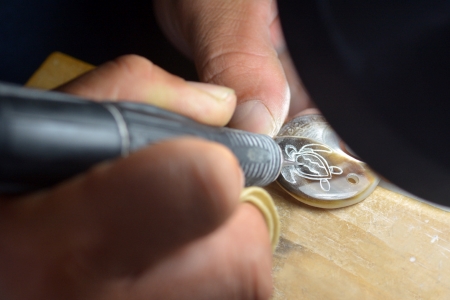Both etching and engraving are great for creating unique, personal jewellery designs, but it can be tricky figuring out which is the best process for you. The main difference is the amount of metal that’s removed. Etching only takes away the top layer, where as engraving leaves a much deeper incision.
The etching process
A technique traditionally used in printmaking, the etching process is used to create designs on metal, dating back to the Middle Ages. Etching is typically performed on copper or zinc, but can work on most other metals too. The sheet metal is prepped with an acid-resistant wax or ‘ground’ to draw the lines into, then once submerged in acid the exposed metal is ‘bitten’, leaving incised markings.
As technologies have progressed, new forms of etching have become available – such as laser etching. This method is significantly different to the traditional etching process, as you’ll find out later on.
The engraving process
Developed as a printmaking method in the 15th century, engraving is a technique where a plate of soft metal is cut into with a ‘burin’ tool to create an image. To preserve the engraving, the ‘steel facing’ process was made in the mid-19th century in France and is still used to this day.
Thankfully, nowadays various tools have been invented to make the job easier and more versatile. For example, the Dremel Engraver is a handheld tool used to engrave on not just metal, but a range of other materials like wood, plastic and ceramics.
Laser etching vs laser engraving

Similar to the traditional processes, it’s important to understand the key differences between laser etching and laser engraving. With both methods using a high heat beam to melt the material, they’re equally as effective at making designs in a metal of your choosing. However, there are a few things to consider when weighing up the pros and cons of laser etching vs laser engraving for jewellery making.
When it comes to laser engraving, this is likely to withstand more wear and tear from handling than laser etching. Although, laser etching may be a more appropriate choice for safety-critical parts, as engraving can cut too deep and subsequently damage vital parts of the design.
Now you know more about the differences between etching and engraving, hopefully you feel more confident to try out each method and find out which is best for you.
Be sure to share your personalised creations with us on social media, tagging in Cooksongold on Facebook, Twitter and Instagram.

Cooksongold

